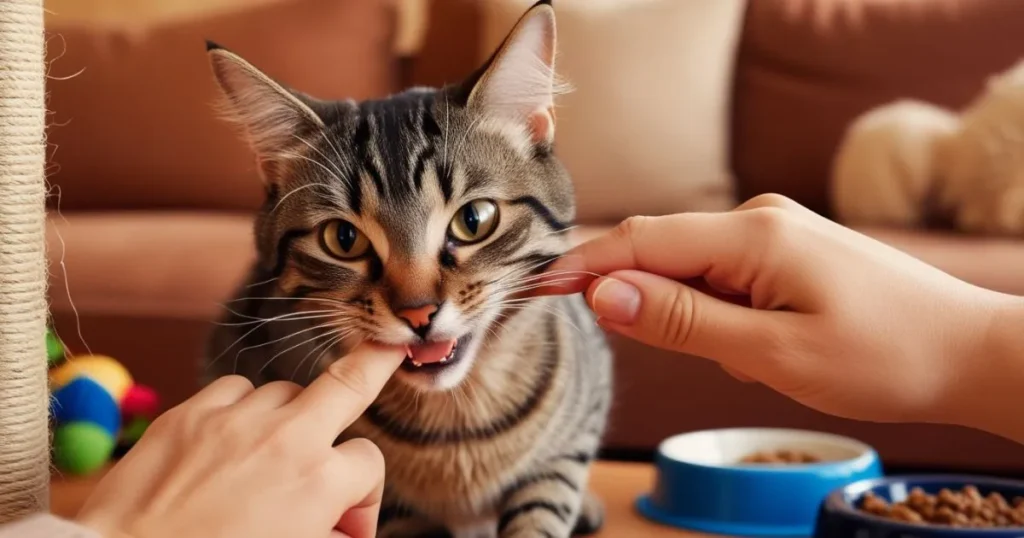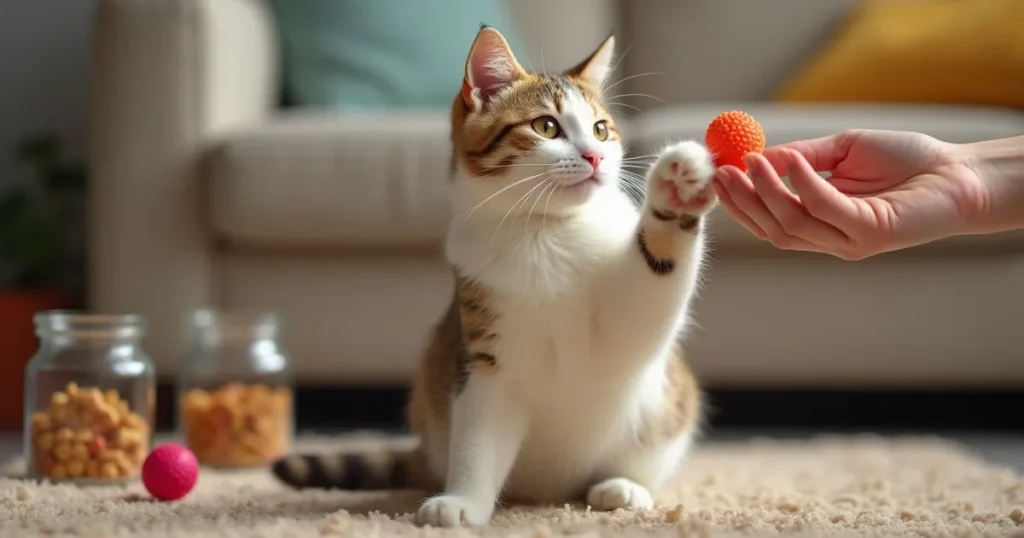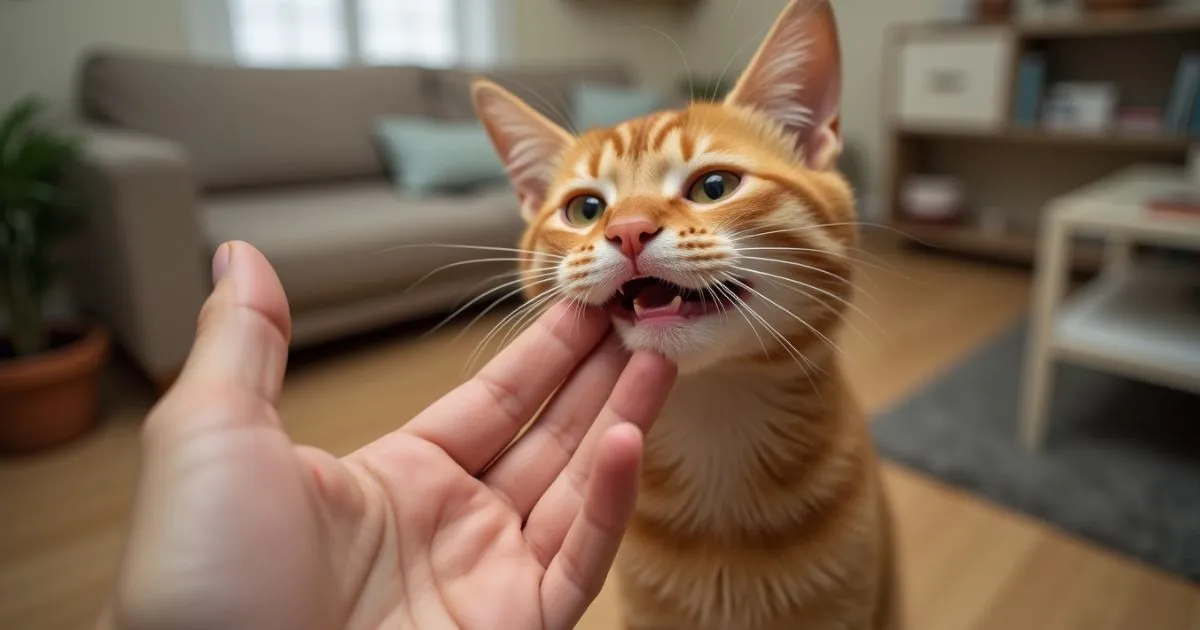My cat keeps trying to eat my fingers, What’s the reason? If you’ve found yourself wondering about this peculiar feline behavior, you’re not alone. Many cat owners experience those playful, sometimes slightly uncomfortable moments when their furry companion seems intent on gently (or not so gently) chomping down on human digits. While it might seem bizarre or even slightly concerning, this behavior is actually quite common and typically rooted in a few fascinating aspects of feline communication and instinct.
From playful kittens to adult cats, the tendency to nibble or “mouth” human hands can stem from various psychological and biological factors. Understanding why your cat keeps trying to eat your fingers can help you better interpret their behavior, strengthen your bond, and potentially redirect their nibbling instincts more appropriately. Whether it’s a sign of affection, a form of play, or a communication attempt, these tiny teeth-meets-skin moments are more complex than they might initially appear.
Table of Contents
Understanding why my cat keeps trying to eat my fingers?
Our cats often bite our fingers, a behavior that can puzzle us. This action is rooted in feline instincts developed over time. To grasp why your cat bites your fingers, we’ll look at predatory behavior and early life experiences.
The Role of Predatory Behavior in Domestic Cats
Domestic cats have natural feline instincts to hunt. This behavior includes pouncing, stalking, and biting. When they see fingers moving, they might bite to explore and play.
How Early Life Experiences Shape Biting Habits
Early life shapes a cat’s feline instincts and biting habits. Kittens who are socialized well and interact positively with humans tend to play with toys, not fingers. On the other hand, cats with limited human interaction or rough handling may see fingers as prey.
Knowing these factors helps you manage your cat’s behavior. It allows you to redirect their play towards toys and away from fingers.
Signs Your Cat’s Finger Biting Is Playful vs. Aggressive
It’s important to tell if your cat is just playing or being aggressive when they bite your fingers. Knowing the difference helps you stop bad behavior. Watch your cat’s body language and actions to determine why they bite your fingers.
Playful biting is soft and gentle. Your cat will seem relaxed and their eyes will be wide. They might kick their back legs or wrap their paws around your hand, showing they want to play. But, if they bite hard and seem tense, it’s likely aggressive biting. They might have flat ears and a narrow gaze.
- Playful Biting: Soft, gentle nibbles; relaxed body posture; dilated pupils; kicking with hind legs; paw wrapping
- Aggressive Biting: Sharp, forceful chomps; tense body; flattened ears; narrowed gaze
By knowing these signs, you can understand what your cat wants. If they’re just playing, you can give them toys to bite instead. But if they’re being aggressive, you should teach them better behavior.
My cat keeps trying to eat my fingers: Common Triggers and Causes
If your cat keeps nibbling on your fingers, it’s important to know why. Cats have feline instincts that make them want to explore, including your hands. But, there are many reasons why they might do this, like boredom or stress.
Environmental Factors That Encourage Biting
Changes in your cat’s world, like a new home or pet, can make them bite more. They might feel stressed or anxious, leading to biting as a way to cope.
Also, if your cat is bored or not getting enough mental stimulation, they might bite your fingers. Giving them lots of toys and activities can help them find better ways to play.
Physical and Emotional States That Lead to Finger Biting
- Pain or discomfort, like dental problems or arthritis, can make your cat more sensitive and prone to cat keeps trying to eat my fingers behavior.
- Stress, anxiety, or fear can trigger a defensive response, leading to increased biting as a way to protect themselves.
- Playfulness and hunting instincts can also contribute to desire to my cat keeps trying to eat my fingers, as they may see my hands as prey to be caught and pounced on.
Understanding why your cat bites your fingers is the first step to solving the problem. It helps you find ways to change their behavior.
The Connection Between Finger Biting and Cat Communication

As pet owners, we might see our cats nibbling or biting our fingers. This behavior can be worrying, but it’s often a way for cats to communicate. Learning about cat biting my fingers and feline body language helps us understand why does my cat bite my fingers, and how to react.
Cats are naturally inclined to bite, a skill they learn from a young age. Kittens play bite with their siblings and mothers, practicing their hunting skills. This early experience can influence their adult behavior, leading them to use their teeth to explore and interact with humans.
But why do cats bite our fingers? It’s not always just play. Cats might bite to:
- Seek attention – They might want your focus and playtime or petting.
- Communicate overstimulation – If they feel too excited or overwhelmed, biting can mean “I’ve had enough.”
- Express discomfort or stress – Cats may bite when they feel scared, threatened, or uncomfortable.
Understanding your cat’s feline body language and why they bite can help you respond better. By noticing the context and your cat’s mood, you can tell playful nips from aggressive bites. This knowledge helps you change their behavior and strengthen your bond.
How Previous Owner Interactions Influence Biting Behavior
As a cat owner, it’s key to grasp how your cat’s past affects their biting. Early socialization and learning from past interactions shape their redirectable behavior and feline instincts. This is crucial for stopping cats from biting.
Impact of Early Socialization
Proper socialization in a cat’s early years is vital. Kittens that have good interactions with humans and animals tend to bite less. Cats that faced neglect, abuse, or poor socialization might bite more.
Learning Patterns from Past Experiences
Cats learn a lot from their past, including interactions with previous owners. If they were rewarded for biting, they might keep doing it. But, cats trained to avoid biting with positive methods tend to behave better.
Knowing your cat’s past helps you train them better. With patience and the right methods, you can teach your cat to stop biting. This way, they’ll develop more positive behaviors.
Medical Conditions That May Cause Excessive Finger Biting
If your cat keeps biting your fingers, there might be a health reason. Some health issues can make cats bite more. Knowing these can help you fix the problem.
Dental problems are a common cause. Cats with sore teeth might bite their fingers to feel better. Taking your cat to the dentist regularly can help find and fix dental issues.
Pain from arthritis or injuries can also make cats bite more. They might bite to get attention or relief from pain. A vet can check for these health problems.
Neurological disorders or other health issues might also cause biting. Cats with brain problems might bite compulsively. A vet visit can check if this is the case.
If your cat bites a lot, see a vet. They can check for health problems and help you stop the biting. Fixing health issues can make your cat more comfortable and bite less.
Effective Training Methods to Stop Finger Biting

Dealing with a cat that bites your fingers can be tough. But, there are ways to stop this behavior. By using positive reinforcement and redirecting your cat, you can teach them not to bite your fingers. This way, they learn better ways to play.
Positive Reinforcement Techniques
Positive reinforcement is a great way to stop your cat from biting. Offer them positive reinforcement, such as snacks or verbal encouragement, for gentle play. Redirectable behavior can be encouraged by giving them toys to chew on instead of your fingers.
Redirecting Unwanted Behavior
Guiding your cat away from biting fingers toward more appropriate activities is crucial. If your cat is about to bite, distract them with a toy or treat. Praise them when they play with the new object. This teaches them that fingers are not for biting.
Being consistent is crucial when training your cat. Stay patient and keep trying. With time, you can stop your cat from biting your fingers and have better interactions with them.
Safe Alternatives to Finger Play: Appropriate Toys and Activities
As a caring pet parent, it’s key to give your cat fun things to do instead of biting your fingers. By giving them safe toys, you can stop them from biting. This helps them use their natural hunting and play instincts in a good way.
Offering a range of cat toys is a great way to stop finger biting. Toys that mimic prey, such as feather teasers or laser lights, are ideal options. They keep your cat busy and happy, redirecting their energy into fun activities.
- Sturdy, durable toys that can withstand energetic batting and pouncing, like plush mice or balls with bells
- Puzzle feeders or treat-dispensing toys that encourage natural foraging and problem-solving skills
- Scratching posts or pads to fulfill your cat’s instinctive need to scratch and mark their territory
Changing your cat’s toys often and introducing new ones keeps them interested. Playing with your cat regularly and giving them lots of things to do helps too. This way, you can stop them from biting your fingers.
Every cat is different, so you might need to try a few things to find what works best. With patience and the right toys and activities, you can change your cat’s biting habits. This makes for a happier, healthier relationship between you and your cat.
Creating Boundaries: Teaching Your Cat Gentle Play
As a responsible pet owner, setting clear rules is crucial. This is especially true for cat biting my fingers. Training and positive reinforcement can teach your cat to play nicely and avoid aggression.
Establishing Clear Rules
Start by telling your cat that fingers are not toys. Show them approved stop cat from biting toys instead. This helps them understand what’s okay to play with.
Consistency in Training Approaches
Being consistent is key in changing your cat’s behavior. Use positive rewards like treats or praise for gentle play. Avoid yelling at or disciplining your cat, as it may escalate the problem. Instead, gently guide them to better play options.
With clear rules and consistent training, your cat will learn to play gently. This way, you can enjoy a happy and healthy relationship with your cat.
When to Seek Professional Help for Biting Behavior
As a cat owner, dealing with cat biting fingers or aggressive behavior can be tough. Some biting is okay, but too much or aggressive biting needs a pro cat behaviorist.
Look for expert help if your cat bites a lot and it’s hard to stop. Or if the biting is serious, like breaking the skin. Also, if your cat bites often and shows other bad behaviors like hissing or growling.
Or if the biting seems linked to a health issue or a big change in your cat’s life. A cat behaviorist can help. They can find out why your cat bites and teach you how to stop it.
They might also suggest talking to a vet. This is to check if there’s a health problem causing the cat biting fingers. Getting help from experts can make your cat’s behavior better. And it will make your relationship with your cat much better too.
Conclusion: My cat keeps trying to eat my fingers
In this article, we’ve looked into why cats might nibble on our fingers. We’ve learned about their natural hunting instincts and how early life and environment play a role. This helps us understand why cats might do this.
Knowing the difference between playful and aggressive biting is important. It helps us figure out why our cats are acting a certain way. We can then teach them to chew on other things instead.
Using positive methods and setting clear rules can help. Giving your cat lots of chances to play naturally is also key. This way, you can enjoy a happy home where your cat doesn’t bite your fingers.
Being patient and consistent is crucial when changing your cat’s behavior. If you’re having trouble, ask for help from a pet behavior expert or vet. With the right steps and understanding, you can make a safe and loving space for your cat.
FAQ
Why does my cat keep trying to eat my fingers?
Cats often try to eat fingers because of their natural instincts. They like to explore with their mouths. You can teach them to play with toys instead.
How can I stop my cat from biting my fingers?
To stop your cat from biting, use positive reinforcement. Give them toys to play with. Set clear rules for when you can touch them. Being consistent and patient is important.
Is my cat’s finger biting playful or aggressive?
Playful nibbling is gentle and fun. Aggressive biting is intense and might mean something’s wrong. Watch your cat’s body language to tell the difference.
What environmental factors can contribute to my cat’s finger biting?
New things in your cat’s world can make them bite more. Boredom, stress, or too much stimulation can also cause it.
How does my cat’s past experience with previous owners affect their biting habits?
What your cat learned from past owners matters. Training them well when they’re young helps prevent bad habits.
Are there any medical conditions that could cause excessive finger biting?
Excessive biting might be a sign of a health problem. Dental issues, pain, or neurological problems could be the cause. Check with your vet to rule out health issues.
What are some effective training methods to stop my cat from biting my fingers?
Positive reinforcement works well. Reward your cat for good behavior. Redirect their biting to toys. Consistency and clear rules are key.
What kind of toys and activities can I provide to redirect my cat’s biting behavior?
Give your cat fun toys like interactive feeders and scratching posts. Play with them regularly. This keeps them busy and prevents boredom biting.
At what point should I consult an expert about my cat’s biting habits?
If your cat’s biting doesn’t stop or gets worse, get help. A cat behaviorist or vet can offer specific advice and help change the behavior.

